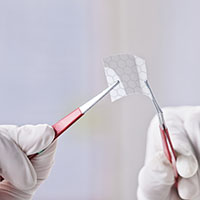Building a strong innovation economy based on graphene
Graphene, a carbon film just one atom thick, will revolutionise how our material world is constructed. First successfully isolated in a European lab ten years ago, the material is 200 times stronger than steel and 70 times more conductive than silicon, opening up opportunities in range of areas from health care to aerospace. Already, graphene-enhanced foldable touchscreen prototypes for laptops and mobiles are being trialled. While European researchers have often been at the forefront of identifying possible new applications for graphene – it was University of Manchester researchers that first identified the material – they have not always been able to commercialise their ideas. This is why the EU has launched a ten-year research fund called the Graphene Flagship, which is about creating the right environment for European innovation to flourish. The EUR 1 billion Flagship, which was launched last year, will help bring ideas to market by coordinating hundreds of research teams and helping them pass their research on to industry. European companies taking part include Nokia, STMicroelectronics, BASF and Airbus. In total, the project includes 142 universities, institutes and companies from 23 European countries. Safety aspects of graphene will also be investigated. Some Flagship-funded prototypes have already been developed, including the successful combination of graphene and plastic to create a pixelated display for electronic devices. By using flexible plastic instead of glass, foldable electronic devices could soon be appearing on the market. This particular prototype is a good example of how partnerships, made possible through the Flagship programme, can accelerate the commercial development of graphene. Indeed, the number of teams involved in the project reflects the dizzying array of possibilities that graphene brings (graphene occurs naturally in graphite, the form of carbon used for pencils). Just one everyday example is the possible replacement of indium tin oxide as a component in the next generation of televisions and electronic displays. Looking further ahead, graphene could be used in clothing to generate electricity, to power devices as you walk, build stronger body armour and offer a lightweight alternative to aluminium in airplanes. Another reason why graphene has attracted so much interest from researchers and businesses in recent years is that the barrier to entry is so low. Isolating graphene does not require expensive equipment or large amounts of investment (bringing graphene-based products to market, of course, is another story). Although sporadic attempts to study graphene can be traced back to 1859, it was not until 2004 that a simple and effective way of producing graphene samples was discovered. Since then, this area of science has grown extremely quickly, with hundreds of laboratories around the world dealing with different aspects of graphene research. Europe must play a full role in the graphene revolution. By taking graphene from the realm of academic laboratories and into European society, the Commission aims to generate economic growth, new jobs and new opportunities for Europeans as both investors and employees. The research effort will cover the entire value chain, from materials production to components and system integration. The Graphene Flagship is being coordinated by Chalmers University of Technology, Gothenburg, Sweden. For further information, please visit: Graphene Flagship http://graphene-flagship.eu/
Countries
Sweden



